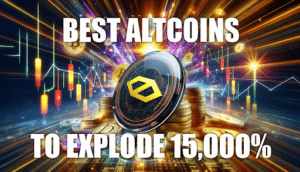The gaming industry is set to undergo some significant changes over the coming years. Innovative concepts such as non-fungible tokens and play-to-earn mechanics change the way people approach games and their content. Whether card-based games or in-game characters, the landscape will look very different in a few years.
The Evolution Of NFTs In Gaming
Whereas most people see non-fungible tokens as digital art, the technology allows for many more use cases. For example, NFTs can provide players with actual ownership of their in-game items and characters in the gaming sector. That ownership will enable players to trade or sell their assets in exchange for real money, creating a different overall economy. Moreover, this approach has tremendous potential to boost player retention, as most games tend to lose their audience after a few months.
The initial concept dates back to CryptoKitties, a blockchain-based collectible game that brought NFTs to a broader audience. The project is successful and is still going strong today, as the breeding-oriented aspect of these digital cats continues to pique people’s interest. Ever since the project launched, NFTs and gaming have undergone a tremendous evolution. Today, the correlation between video games and NFTs has become a lot more outspoken through metaverses, MMORPGs, play-to-earn games, etc.
The NFT movement has not gone unnoticed. Celebrities, artists, business leaders, and other enthusiasts are actively using their influence to bring more attention to non-fungible tokens in the gaming sector. Mainstream adoption of NFT-infused gaming may not happen overnight, but there is tremendous variety in today’s game-related offerings. Axie Infinity is such an example, a project that continues to take the world by storm. Other notable projects include Decentraland, Sandbox, Guild of Guardians, and many others.
Early NFT adopters like Eric Young acknowledge the barrier to NFTs is not necessarily a technical one. Instead, ownership on a digital ledger is everything one needs to understand, making them different from cryptocurrencies with governance, founders, and overall risk factors. Investing in NFTs appears to be more straightforward, even though there is still the risk of never being able to sell them [for a profit]. With in-game items, there is usually an audience looking to create new characters, weapons, or collect everything there is to collect in the game.
Finding The Right NFT Platforms
For both investors and creators, there are several NFT platforms to explore. Marketplaces such as OpenSea, SuperRare, Rarible, and AtomicMarket all note impressive volumes and overall users. Investors and enthusiasts can find a plethora of NFTs, ranging from in-game items to collectibles and artwork. OpenSea has a tremendous 24-hour volume that goes past $75 million per day somewhat regularly.
For gaming enthusiasts, Axie Infinity remains the go-to place. With over 33,000 trades and $33 million in 24-hour volume, the play-to-earn game attracts enthusiasts’ attention globally. Although the recently introduced Season 18 patch notes may create some minor dismay regarding SLP earning rates, it also incentivizes players to become more profound at player-vs-player combat.
Collectibles remain a crucial addition to non-fungible tokens. Projects like CryptoPunks were initially considered a “joke,” yet these non-fungible tokens now have a price floor of over $100,000. Thus, there are many opportunities left to explore with NFTs, including giving them extra use cases in gaming, decentralized finance, insurance, marketing, and so forth. Exploring these options will require more efficient infrastructure capable of handling high throughputs at low or zero fees.
Expanding the Ecosystem With Immutable X
The ongoing growth of NFTs has given rise to several marketplaces, applications, games, and much more. However, all of these solutions will still require an underpinning blockchain – or layer two scaling solution – to provide efficiency, speed, and accessibility. Most of the NFT projects build on Ethereum, a network that isn’t always known for its efficiency. Non-fungible tokens may require native layer two scaling solutions, such as the one provided by Immutable X.
Giving client partners the chance to build new marketplaces, apps, games, and more with instant trade confirmations and high throughput is a game-changer for the broader industry. More importantly, Immutable X providers up to 9,000 trades per second without incurring any gas fees. As a result, the project has become a trusted technology partner for various Gaming, DeFi, Collectibles, and Marketplaces clients. Some people may also recall Immutable as the team responsible for launching Gods Unchained, one of the most popular blockchain card games to date. Over 10,000 wallets hold Gods Unchained NFTs on immutable X today.
The underpinning technology improvements offered by Immutable X have given rise to over 6 million NFTs being minted. More specifically, the network currently averages roughly 3,000 mints per second at zero gas fees. Doing the same on the Ethereum blockchain would cost tens of thousands of dollars in fees alone. If NFTs are to gain mainstream traction, they need to be cheap to mint and broadly accessible. Immutable X makes that a possibility for people worldwide.
As Immutable X is a layer-two solution on the Ethereum blockchain, it is interoperable with other projects. The advantage is how buyers don’t need to change platforms to discover new content. Moreover, exciting projects can gain broader exposure by incorporating the Immutable X protocol. Any developer can create and own their UX and improve the user experience of thousands, if not millions of people.
Disclaimer: This article is provided for informational purposes only. It is not offered or intended to be used as legal, tax, investment, financial, or other advice.





















